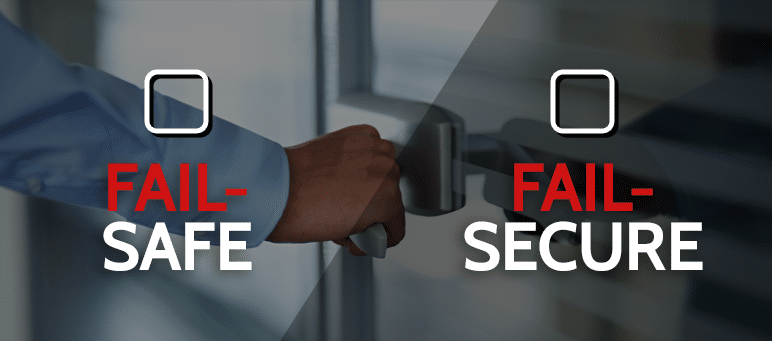If you’re installing a new access control system, it’s essential to know the difference between Fail-Safe and Fail-Secure locks. The right product can make all the difference when it comes to saving a life and keeping your organization safe.
Fail-Safe vs. Fail-Secure
This describes the status of the outside of the door, where you would insert a key or scan a badge. Our technology partners from Allegion define the difference as:
- Fail-Safe: Unlocked when power is removed. Power is applied to lock the door. Commonly used in lobbies and stairwells.
- Fail-Secure: Locked when power is removed. Power is applied to unlock the door. Commonly used in IT rooms, storage closets, and sensitive areas.
Your space will likely need a combination of fail-safe and fail-secure locks to keep your organization safe. During an emergency, you want people to move freely throughout a space, but there are certain areas of the building that may not need unlimited access every time there’s a power outage.
Fail-Safe Locks
Fail-safe locks are intended to keep people safe. For example, if there’s an emergency and the power’s gone out, stairwell doors and entry points should be unlocked so fire and medical personnel can quickly enter the building.
Power consumption is also something to consider. Fail-safe locks are more expensive since they constantly require power to provide security.
(Related: 9 Workplace Security Best Practices - Are You Jeopardizing Your Business?)
Fail-Secure Locks
Fail-secure locks are intended to keep things secure. For example, if a bad storm causes the power to go out, you still want to limit access to IT rooms or storage closets. Since these doors default state is locked, most can be manually unlocked with a key as a back-up precaution.
Additionally, electric strikes on fire doors must be fail-secure, so the door is positively-latched if there is a fire. Doing so keeps areas and stairwells closed-off to help keep a fire from spreading. While you need a fail-secure electric strike, it’s recommended to have a fail-safe door.
Egress
Remember, fail-safe and fail-secure describes the status of the outside of the door. It regulates entry into a space. In the event of a fire or other emergency, when people need to exit the building, both locks still permit egress.
- Egress: The action of going out of or leaving a place
This means you can always exit a space, regardless of the power situation.
Which do you need, Fail-Safe or Fail-Secure Locks?
One isn’t better than the other; it’s just a matter of which one will accomplish your goals for that specific door. Every building requires fire exit doors, so by default, you’ll have fail-safe locks. However, with cost and security in mind, you’ll likely want fail-secure locks too.
Use the following questions to guide your decision.
- During a power outage, would the locked door endanger lives? If yes, use fail-safe.
- During a power outage, would the unlocked door put valuables or sensitive information at risk? If yes, use fail-secure.
So, how are you providing access control, safety, and security in your workplace environment? Employers, IT professionals, and facilities managers must answer this question when considering upgrades, renovations, new office construction, and national rollouts.
If you’re unsure what’s the right solution for your space, our team of experts can help create a plan that will keep your organization safe and secure.
Use our Project Budget Calculator to estimate how much your next security project will cost. Ready to speak with a representative? We can answer questions and value-engineer a solution for your organization, Contact Us today!
Attribution: Lori Greene, Manager of Codes & Resources for Allegion.
Editor's Note: This post was originally published in November, 2017 and has been updated for freshness, accuracy, and comprehensiveness.



Leave a Comment